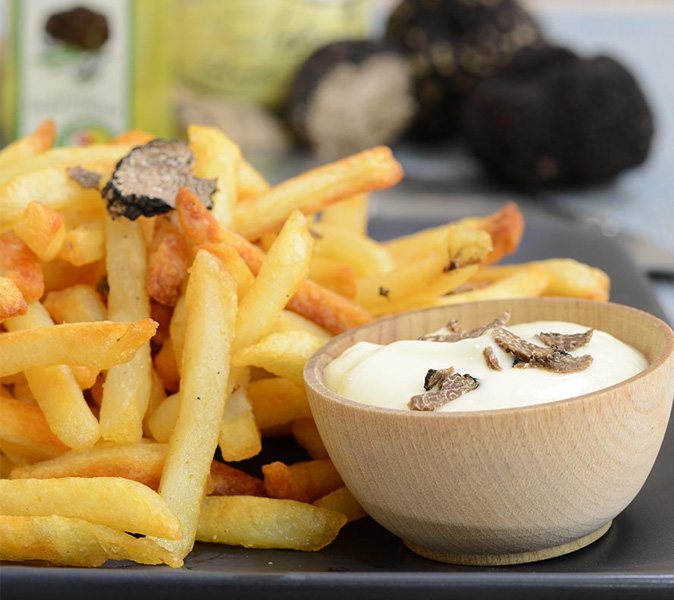Preserved gourmet truffles take about 60% of the total world’s market share of truffles, as they are the best way to obtain this delicacy while not in season. There are different ways of persevering truffles, but you want to look for premier cuisson or “first cooking” or “first boiling” truffles. Truffles are preserved in cans and jars, which provides the customer with a bigger window for using. Typically, First Choice (smaller, berry-size) will be heated with a little water or boiled in brine (a salty solution, essentially pickled) and hermetically sealed in a sterilized jar. Another popular preserving method is storing them in oil.

Although very rarely sold, you might stumble upon jarred truffles labeled “second boiling”, which means that the juice is extracted – more often than not to be sold separately - by cooking or boiling the truffle twice. The flavor and aroma will be greatly diminished- but so will the price.
The truffles have the advantage of having a longer shelf life, typically from 1 to 2 years. There are many different varieties: some are whole, cleaned (or not) or brushed, while others are already peeled, cleaned, brushed, and sliced (which means less work for you.
One of the many advantages of this type of product is that they last longer and you don’t have to rush to use them. They are very versatile, and you can get two products in one, as the juice or oil in which they are preserved can be utilized as well to flavor soups, broths and sauces. Yes, everybody would love to get fresh gourmet truffles, but this is your best bet, especially if you’re just delving into this world. If you must have fresh truffles, I would suggest taking several practice runs.

Preserved Truffle Presentations
- Whole: This is the most popular form or presentation , especially since it adds a certain visual appeal. Others say the flavor and aroma is preserved better inside. They can be peeled, brushed and/or cleaned, in which case they are ready to use, or unpeeled, and dirty
- Chopped/ Sliced: The work has already been done for you. Brushed, cleaned, and sliced or chopped. If you can afford it, it will save you some dirty work.
- Peeled: If you don’t wish to use the peelings, save them, and use them to garnish or flavor oils, soups, broths, or sauces.
- Brushed: Have been gently brushed and cleaned to remove the dirt.
- Flash Frozen: Frozen extremely quickly to preserve flavor and aroma.
Types of Preserved Truffles
Preserved truffles come in various types, each offering a different flavor intensity and use in the kitchen. The most common are black truffles, which maintain more of their earthy aroma even after preservation. They are perfect for sauces and pasta dishes. White truffles are less commonly preserved but can still be found, offering a more delicate, garlicky flavor. Summer is another popular option, known for their milder taste and versatility. Each type brings unique characteristics to a dish, making them ideal for experimenting with a variety of recipes.
Storage and Preparation
- They can be stored at room temperature, and have a shelf life between one to two years.
- After opening, store in the refrigerator and use within one to two weeks.
- For best taste, premier cuisson should be used immediately after opening.
- They can also be frozen in a freezer-proof jar for about two weeks (although I wouldn't recommend this option).
How to Choose Quality Preserved Truffles
Look for labels that specify premier cuisson, indicating it has been boiled only once, preserving more of its natural aroma and taste. Check for clear packaging where you can see the truffle — this will help you assess its quality. It should appear whole or in substantial slices, rather than crumbled. Always read the ingredients to ensure the preservation method uses minimal additives, relying on natural oils or brine for flavor retention. Also, the origin and the type (black, white, summer) should be clearly labeled, ensuring you're getting exactly what you’re looking for.

Cooking with Preserved Truffles
If you have eaten or cooked with Fresh Truffles before, don’t expect to get the same flavor right out of the jar. Although aromatically exceptional in their own right, the process masks their original Fresh flavor, so a couple of quick steps need to be taken to uncover their flavor again.
Pairing Preserved Truffles with Other Ingredients
Preserved truffles are incredibly versatile and can enhance a wide range of dishes when paired correctly. They work beautifully with rich, creamy dishes like risottos and pastas, where their earthy flavor can shine. They’re also excellent with meats — especially beef and game — or even roasted vegetables. To amplify the flavor, pair them with complementary ingredients like Parmesan, butter, eggs, and mushrooms. You can also pair with subtle ingredients like mashed potatoes or polenta, allowing the truffle to be the star of the dish. For a luxurious touch, drizzle truffle oil or finish with salt.
Common Mistakes to Avoid When Using Preserved Truffles
One of the biggest mistakes is using them straight from the jar without enhancing their flavor. As mentioned, always dry them and lightly sauté to bring out their taste. Another error is overcooking them — preserved truffles should always be added toward the end of the cooking process, as prolonged heat can diminish their already subtle flavors. Also, avoid pairing them with ingredients that are too strong, such as spicy foods or overly acidic dishes, which can overpower the truffles' delicate aroma.